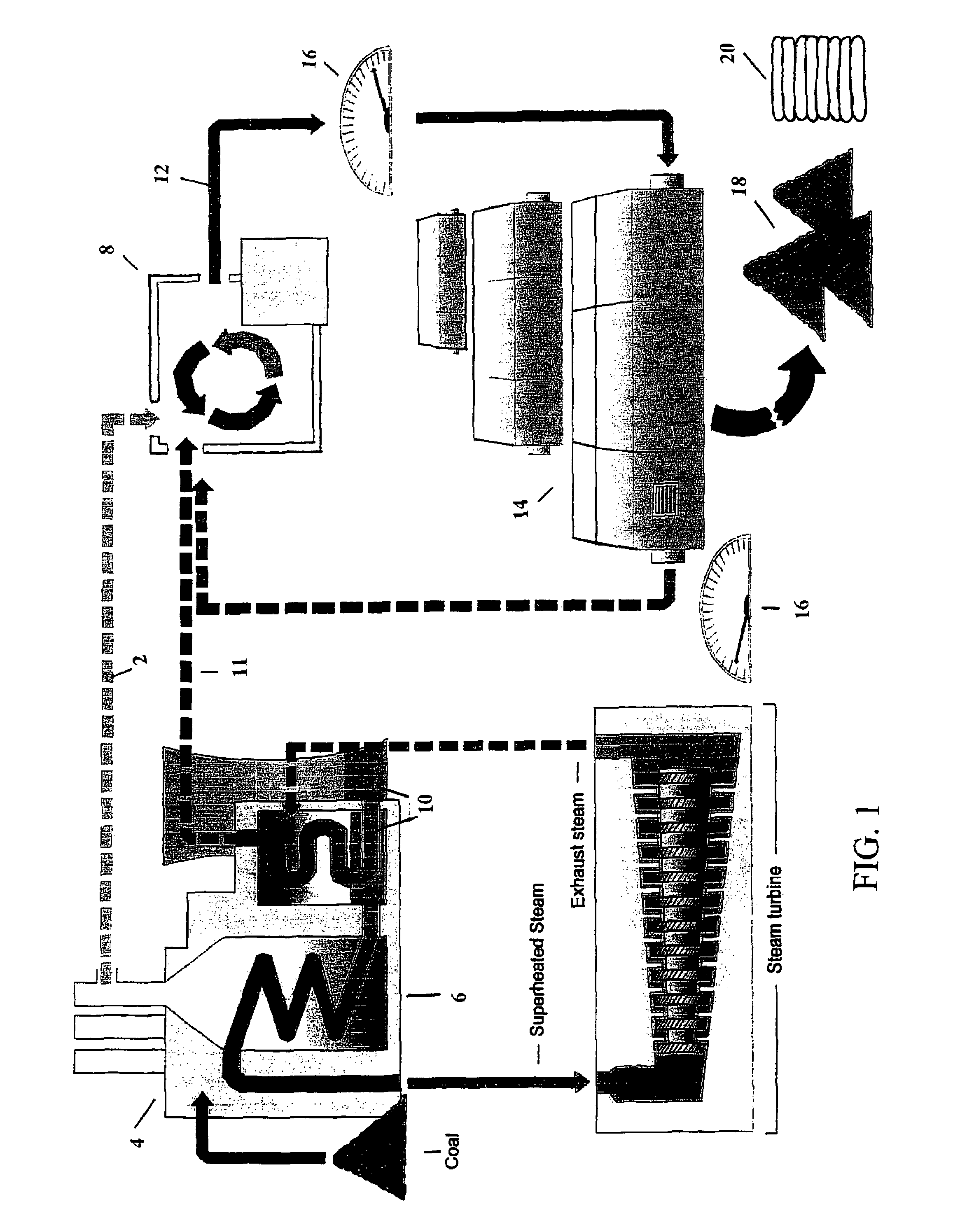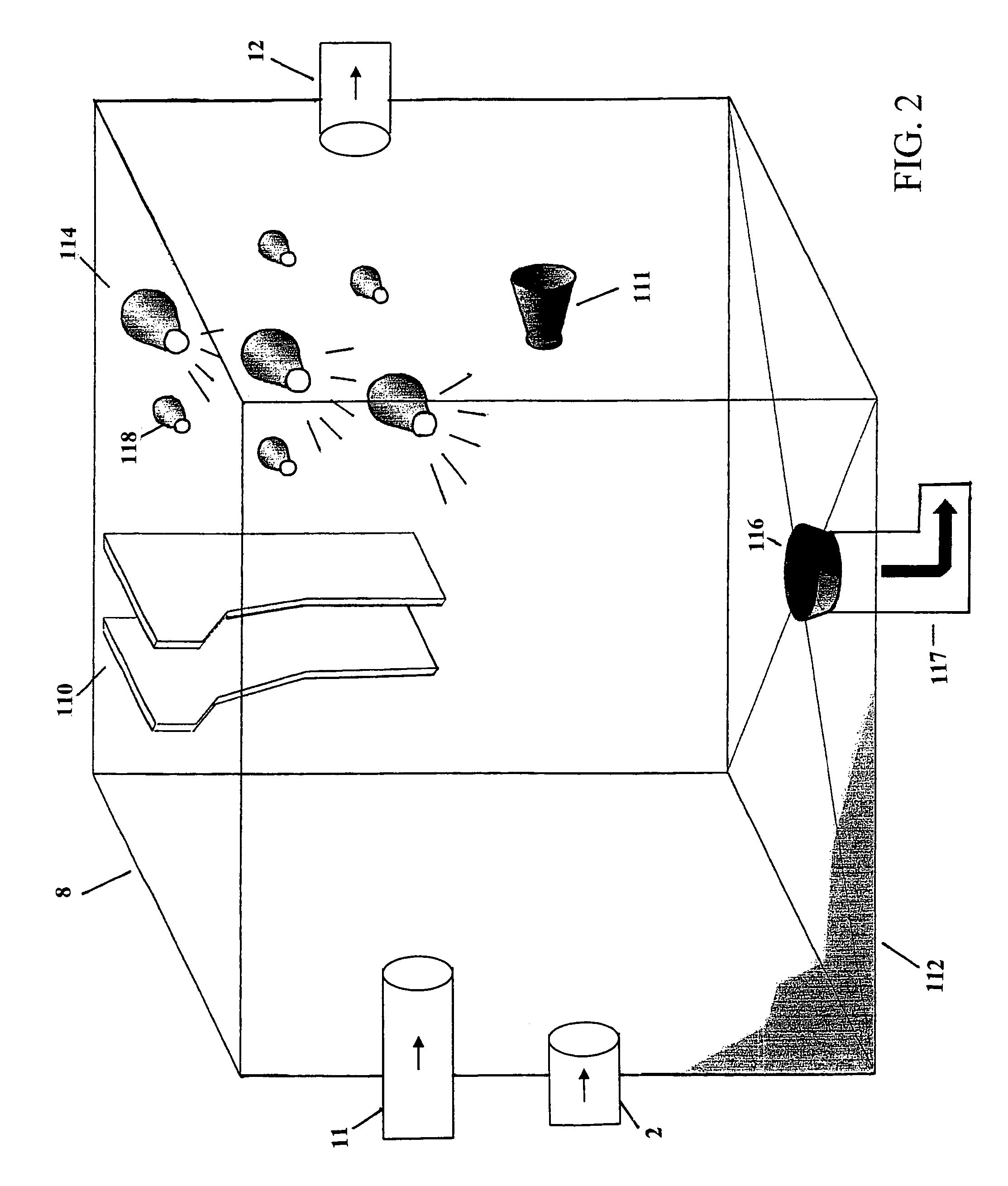Process to produce a commercial soil additive by extracting waste heat, exhaust gas, and other combustion by-products from a coal power generator
a technology of exhaust gas and coal power generator, which is applied in the direction of soil conditioning composition, application, energy input, etc., can solve the problems of difficult to use commercial horticultural and agricultural additives, and achieve the effect of maximum growth of bio-mass materials and low cos
- Summary
- Abstract
- Description
- Claims
- Application Information
AI Technical Summary
Benefits of technology
Problems solved by technology
Method used
Image
Examples
example 1
Growing Cells 14
[0022]FIG. 1 shows a first preferred embodiment whereby the exhaust product 12, upon leaving the mixing chamber 8, is blown through a series of growing cells 14, preferably horticulture growing frames, tailored to available growing space, climate and other factors. In a preferred embodiment, a 50′×300′ horticulture hoop house with bottom heating cables, supplied from the waste heat of the mixing chamber 8, may be used. It is also preferred that the growing cells 14 have access for plant farming and harvesting. For example, in northern latitudes, apex hoops for snow loads would be recommended. Additionally, it is preferred that UV treated plastic be used because of its economical year round use. A base growing soil, preferably at least one foot above the heating cables, would be a recommended thickness for maximum growth. The number of frames is proportional to the amount of exhaust gas 12, allowing extra frames for removal of the bio-mass material, cleaning and repai...
example 2
Growing Cell Pond
[0030]As shown in FIG. 4, instead of blowing the exhaust product 12 into the air space of the growing cells 14, the exhaust product 12 is pumped into bubbling devices 302, preferably bubbling tubes, located within a growing cell pond 304, such as a closed growing pond. The bubbling devices 302 are preferably submerged about 6 feet below the water surface of the growing cell pond 304. The growing cell pond 304 may be located within a preferred commercial hoop structure 306. A pressure switch controls the pumping of the exhaust product 12 to maintain higher pressure than the bottom liquid pressure and bubbles the exhaust product 12 through water which is monitored for temperature, pH, and nutrient content by similar space gas detection units as previously mentioned. Fertilizer, lime, or other controlling material can be added directly to the water. A propeller or water jet is installed to retain circulation. Waste heat from the mixing chamber 8 can directly warm the w...
example 3
Deep Water Growing Cells
[0033]FIG. 5A and FIG. 5B show a preferred embodiment dealing with either pumping exhaust product 12 from a mixing chamber 8 or pumping nutrient rich water 222 from a pressurized water filled mixing chamber 208 directly into deep water growing cells 402, 404, 406 preferably up to 10 meters or more. When exhaust product 12 is pumped to the deep water growing cells 402, 404, 406 the exhaust product 12 is provided using bubbling devices 408. The dimensions of the deep water growing cell 402, 404, 406 depends on the area availability and the throughput of exhaust product 12. The deep water growing cells 402, 404, 406 may be open growing ponds, fresh water, or salt water growing cell. The deep water growing cells 402, 404, 406 can be separated by earthen dikes, wire nets with tyvec type fabric separation or even open net (nylon or poly) that encourages bio-mass material growth while limiting mixing between deep water growing cells 402, 404, 406. Bio-mass material ...
PUM
| Property | Measurement | Unit |
|---|---|---|
| thickness | aaaaa | aaaaa |
| pH | aaaaa | aaaaa |
| areas | aaaaa | aaaaa |
Abstract
Description
Claims
Application Information
 Login to View More
Login to View More - R&D
- Intellectual Property
- Life Sciences
- Materials
- Tech Scout
- Unparalleled Data Quality
- Higher Quality Content
- 60% Fewer Hallucinations
Browse by: Latest US Patents, China's latest patents, Technical Efficacy Thesaurus, Application Domain, Technology Topic, Popular Technical Reports.
© 2025 PatSnap. All rights reserved.Legal|Privacy policy|Modern Slavery Act Transparency Statement|Sitemap|About US| Contact US: help@patsnap.com



